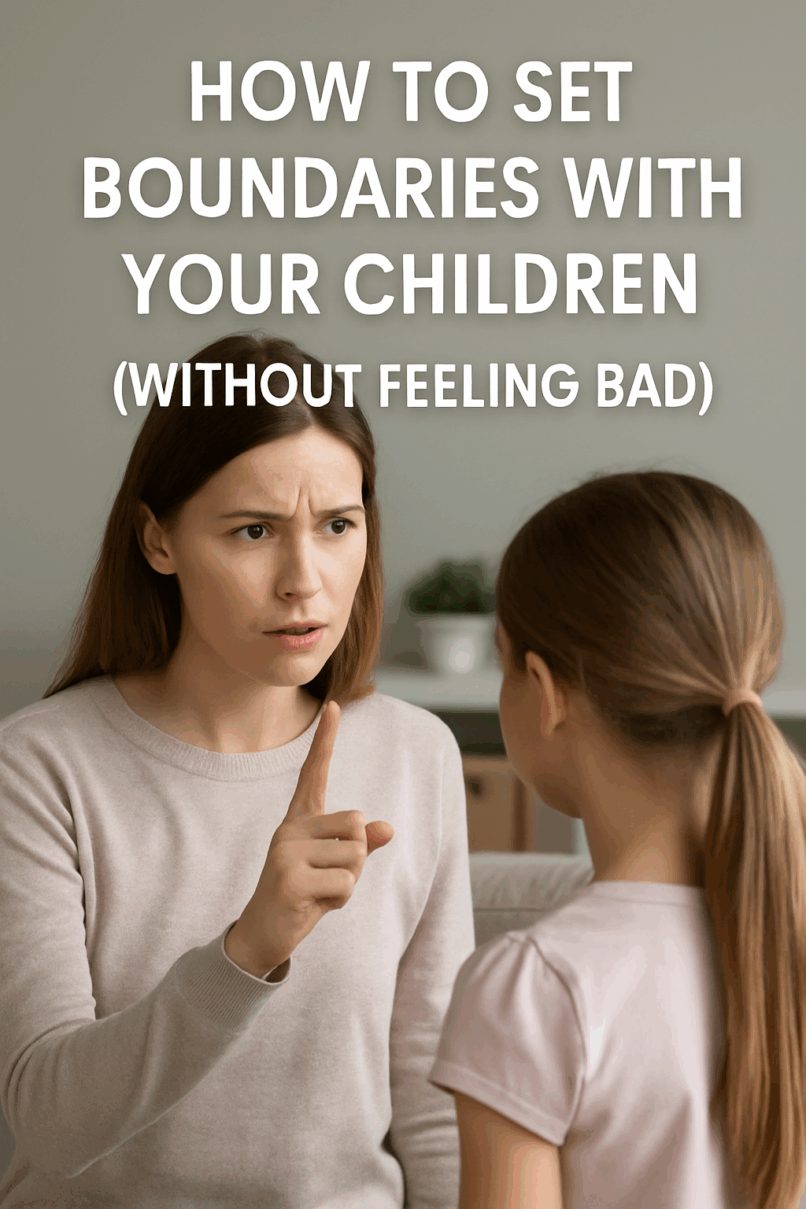
simply amazing, always for you.
The Misunderstood Power of Boundaries in Parenting
As a parent, you want the best for your child. You want them to feel loved, supported, and free to express themselves. But somewhere along the way, the word “boundaries” began to feel like the opposite of love—something cold, rigid, even cruel.

You’re not alone.
Many parents struggle with setting clear boundaries because they fear it’ll damage their bond with their children. Others simply don’t know how to implement limits without yelling, guilt-tripping, or shutting their child down.
But here’s the truth: Boundaries are not barriers to connection—they’re the foundation of it.
This article is here to help you reframe boundaries as acts of love and protection. We’ll explore:
- Why setting boundaries matters
- How to implement them effectively
- How to stay consistent without guilt
- How to evolve boundaries as your child grows
And yes, we’ll tackle the hardest part: how to stop feeling bad when you enforce them.
By the end of this guide, you’ll feel confident, grounded, and empowered in your parenting approach.
Chapter 1: What Boundaries Really Mean (And Why They’re Critical)
Before you can set boundaries, you have to understand what they are—and what they are not.
Boundaries are:
- Guidelines that create safety and structure
- Clear limits around behaviors, time, and expectations
- Tools that teach children about respect—for others and themselves
Boundaries are not:
- Punishment
- Authoritarian control
- Rejection or emotional withdrawal
Think of boundaries as guardrails on a bridge. They don’t restrict the journey—they protect it.

A child without boundaries may feel:
- Anxious and unsafe
- Confused about expectations
- Entitled or disrespectful toward others
Boundaries provide the emotional container children need to explore, grow, and thrive.
Related reading: How to Be a Patient Parent: Tips for Managing Your Emotions
Chapter 2: The Parent Guilt Trap—and How to Break Free
The moment you enforce a boundary, guilt can come knocking:
- “What if they hate me?”
- “Am I being too harsh?”
- “I just want them to be happy.”
Here’s what you need to remember: A boundary is not a betrayal of love. It is love made visible.
Your role is not to make your child feel good all the time. Your role is to help them become a well-adjusted, emotionally mature adult. That often means choosing what’s right over what’s easy.
Common guilt triggers:
- When your child cries or throws a tantrum
- When they say things like, “You’re mean!” or “I hate you!”
- When they compare you to other parents
- When you break your own “nice parent” identity
How to handle guilt:
- Acknowledge it—but don’t obey it.
- Remind yourself of the why behind the boundary.
- Practice self-compassion. You’re learning too.
Related reading: How to Deal with Parenting Burnout and Find Your Energy Again
Chapter 3: How to Set Clear, Firm, and Loving Boundaries
Let’s get into the nuts and bolts of boundary-setting. Every healthy boundary needs three parts:
- A clear limit
- A consistent consequence
- A calm delivery
1. Be specific and clear
Instead of vague rules like “be good” or “act nice,” define exactly what you expect.
Examples:
- “No hitting. We use words to express feelings.”
- “You can watch TV for 30 minutes after homework is done.”
- “You need to brush your teeth before bed every night.”
2. Use logical or natural consequences
This reinforces accountability without harshness.
Examples:
- If a toy is thrown, it’s taken away for a day.
- If they forget their lunch, they experience going without it.
- If they don’t do homework, they accept the teacher’s response.
3. Stay calm and grounded
Your delivery affects how the boundary is received. Yelling weakens authority. Calm confidence builds trust.
Pro tip: Use “when/then” or “if/then” language:
- “When you’ve cleaned your room, then we’ll go to the park.”
- “If you continue yelling, we’ll take a break and try again later.”
Chapter 4: Giving Autonomy Within Boundaries
Kids don’t want total freedom. What they want is power with parameters.
Offer choices within limits:
- “Do you want to wear the red shirt or the blue one?”
- “Do you want to do homework before or after dinner?”
- “Do you want to read or draw during quiet time?”
This gives children a sense of control, which reduces power struggles—without compromising the boundary itself.
Why it works:
- Kids feel respected
- They learn decision-making skills
- It de-escalates defiance
Related reading: 10 Simple Parenting Hacks Every Mom and Dad Should Know
Chapter 5: Respect Your Child’s Developmental Stage
Not all boundaries are one-size-fits-all. A toddler’s boundaries won’t be the same as a teenager’s. Age matters.
For toddlers and preschoolers:
- Keep boundaries simple and repetitive.
- Use visual cues and routines.
- Be physically present to enforce limits (e.g., remove them from danger).
For school-aged children:
- Set routines for homework, screen time, chores.
- Use natural consequences.
- Explain the why behind boundaries.
For tweens and teens:
- Involve them in boundary-making discussions.
- Give more privacy but keep communication open.
- Focus on trust, not control.
Tip: Revisit and revise boundaries every 6–12 months to keep them relevant.
Chapter 6: What to Do When Boundaries Are Challenged
Children will test boundaries. This is not disrespect—it’s development.
Here’s what to do:
- Stay calm. Don’t personalize their resistance.
- Stay firm. Repeat the boundary without backing down.
- Follow through. Consistency is everything.
Example:
If your child throws a tantrum after screen time ends:
- Acknowledge the feeling: “I know you want more time.”
- Reinforce the limit: “Screen time is over for today.”
- Offer a transition: “Let’s pick a book to read together.”
Do not negotiate with a tantrum. Wait for calm, then revisit the discussion if needed.
Related reading: How to Discipline Your Child Without Yelling or Punishing
Chapter 7: How to Handle Pushback Without Losing It
What if your child pushes back—hard?
You might hear:
- “You’re so unfair!”
- “Why can’t I?”
- “You don’t love me!”
Your response:
- Validate the feeling: “I see you’re upset. That makes sense.”
- Hold the boundary: “This is the rule, even when it’s hard.”
- Stay connected: “We can talk more about it later.”
Avoid overexplaining, debating, or lecturing. That fuels defiance. Stick to the boundary and stay connected emotionally.
Chapter 8: The Power of Repair After Conflict
Sometimes, despite your best efforts, you’ll lose your temper. You’ll set a boundary poorly. You’ll yell. You’ll give in. You’re human.
Here’s the golden parenting skill: the repair.
After a mistake:
- Acknowledge it: “I didn’t handle that well.”
- Apologize: “I’m sorry I yelled. That wasn’t okay.”
- Reconnect: “Let’s try again together.”
This teaches kids that relationships can survive conflict—and it models emotional maturity.
Chapter 9: Boundaries Are Not Just for Children—They’re for You Too
Don’t forget: your boundaries matter, too.
Examples of parental boundaries:
- “I need 10 minutes to finish this before I can play.”
- “You may not scream at me. We can talk when you’re calm.”
- “After 9 p.m., it’s quiet time so I can rest.”
When you model boundaries for yourself, your children learn by example.
Related reading: [How to Balance Parenting and Personal Time Without Feeling Guilty]
Chapter 10: When Boundaries Build Connection, Not Distance
Many parents worry that setting limits will damage the relationship. But the opposite is true.
Boundaries build connection when they’re:
- Predictable
- Respectful
- Grounded in love
They help children feel safe, seen, and secure—even when they push back.
Real-life examples of boundaries that build trust:
- Saying “no” to more candy, but offering a healthy snack with them instead
- Enforcing a rule, then sitting with them while they calm down
- Holding firm while staying warm, open, and nonjudgmental
You Can Be Both Loving and Firm
Setting boundaries with your children doesn’t make you harsh, mean, or controlling. It makes you a parent they can trust.
You can be kind and consistent.
You can be compassionate and clear.
You can say “no” with love—and still be the parent your child runs to for comfort.
Boundaries aren’t about controlling your child. They’re about guiding them toward self-discipline, respect, and emotional intelligence.
And when you do it without guilt? You become the calm, confident leader your child needs most.

Support Our Website!
We appreciate your visit and hope you find our content valuable. If you’d like to support us further, please consider contributing through the TILL NUMBER: 9549825. Your support helps us keep delivering great content!
If you’d like to support Nabado from outside Kenya, we invite you to send your contributions through trusted third-party services such as Remitly, SendWave, or WorldRemit. These platforms are reliable and convenient for international money transfers.
Please use the following details when sending your support:
Phone Number: +254701838999
Recipient Name: Peterson Getuma Okemwa
We sincerely appreciate your generosity and support. Thank you for being part of this journey!
